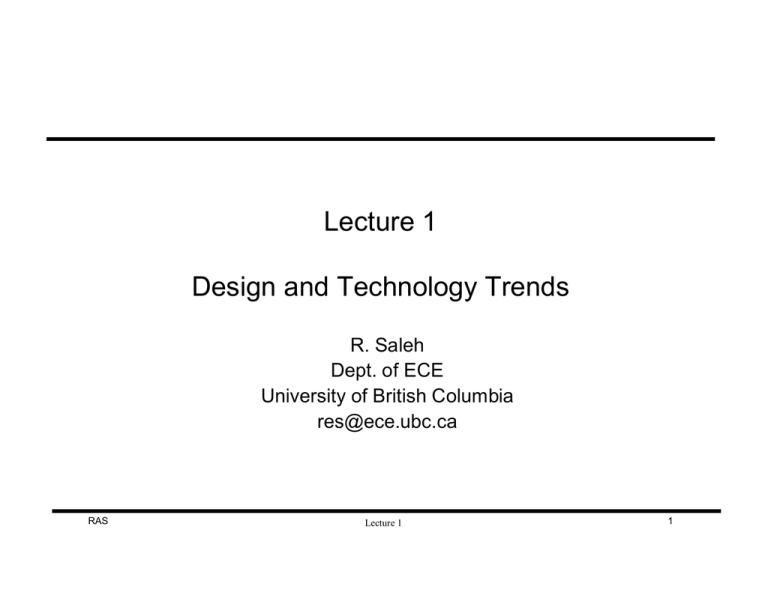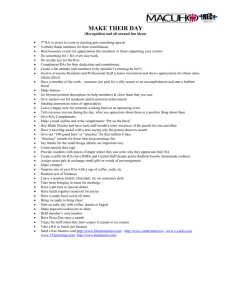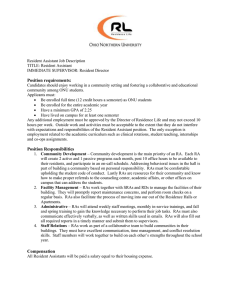Lecture 1 Design and Technology Trends - UBC
advertisement

Lecture 1 Design and Technology Trends R. Saleh Dept. of ECE University of British Columbia res@ece.ubc.ca RAS Lecture 1 1 Recently Designed Chips • Itanium chip (Intel), 2B tx, 700mm2 , 8 layer 65nm CMOS (4 processors) • TILE64 Processor, 64-Core SoC with Mesh NoC Interconnect, 90nm CMOS • 153Mb-SRAM (Intel), 45nm, high-k metal-gate CMOS • FPGAs recently fabricated in 45nm • What are the major technology and design issues that are driving the IC industry? Let’s start from the simple rules of MOS scaling… RAS Lecture 1 2 MOS Transistor Scaling (1974 to present) Scaling factor s=0.7 per node (0.5x per 2 nodes) Metal pitch Technology Node set by 1/2 pitch (interconnect) Poly width Gate length (transistor) RAS Lecture 1 3 Ideal Technology Scaling (constant field) Quantity Before Scaling After Scaling Channel Length L L’ = L * s Channel Width W W’ = W * s Gate Oxide thickness tox t’ox = tox * s Junction depth xj x’j = xj * s Power Supply Vdd Vdd’ = Vdd * s Threshold Voltage Vth V’th = Vth * s Doping Density, p n+ NA ND NA’ = NA / s ND’ = ND / s RAS Lecture 1 4 Technology Nodes 1999-2019 1999 2001 0.7x 2004 2007 2010 2013 2016 2019 0.7x 180nm 130nm 90nm 65nm 45nm 32nm 22nm 16nm 0.5x N-1 N N+1 Two year cycle between nodes until 2001, then 3 year cycle begins. RAS Lecture 1 5 Forecast Technology Parameters Year 2001 2004 2007 2010 2013 2016 RAS Technology Node(nm) 130 90 65 45 32 22 Physical Gate(nm) 90 53 32 22 16 11 tox (nm) 3.0 2.4 1.7 1.5 1.4 1.3 Dielectric K 3.7 3.0 2.5 2.0 1.9 1.7 Lecture 1 Vdd (V) 1.2 1.1 0.9 0.8 0.7 0.6 Vth (V) 0.34 0.32 0.29 0.29 0.25 0.22 Na (/cm3) 1.0e16 1.4e16 2.0e16 2.9e16 4.0e16 5.9e16 Nd (/cm3) 1.0e19 1.4e19 2.0e19 2.9e19 4.0e19 5.9e19 xj (nm) 67.5 46.7 33.8 23.4 16.6 11.4 6 Where are we now? • • 130nm and 90nm CMOS volume production Early production of 65nm, Leading-edge use of 45nm • • Scaling of gate is leading scaling of wire Scaling is driven by DIGITAL design needs RAS Lecture 1 7 Making Photolithograph Work • RAS Extensive use of OPC and PSM in 90nm and below: Lecture 1 8 Deep Submicron Technology Generations Table 1: Time overlap of semiconductor generations 95 96 97 98 99 00 01 02 350 nm 1 2 3 4 5 -2 -1 250 nm 1 2 -4 -3 -2 -1 -6 -5 -4 -9 -8 -7 03 04 05 06 07 3 4 5 180 nm 1 2 3 4 5 6 7 8 -3 -2 -1 130 nm 1 2 3 4 5 6 -6 -5 -4 -3 -2 -1 90 nm 1 2 3 -11 1-Univerisity 0 -9 -8 research -7 -6 -11 10 - -9 08 09 4 5 -5 Industry -4 -3 development -2 -1 65 nm 1 -8 10 11 2 3 4 Production 12 5 -7 -6 -5 -4 -3 -2 -1 45 nm 1 2 11 10 - -9 -8 -7 -6 -5 -4 -3 -2 -1 -11 -10 -9 -8 -7 -6 -5 -4 Each generation spans ~17 years…we are unlikely to be totally suprised RAS Lecture 1 9 MPU Trends - Moore’s Law Transistors Double Every Two Years 10,000 1000 100 100 Transistors (MT) 10 P6 486 1 Pentium® proc 386 0.1 286 8085 0.01 0.001 Source: Intel RAS ’70 4004 2X Growth in 2 Years! 8086 8080 8008 ’80 ’90 Lecture 1 ’00 ’10 10 More MPU Trends ~40mm Die in 2010? 100 36 28 40 32 Pentium® Pro proc Die size (mm) 486 10 Pentium® proc 386 286 8080 8086 8085 8008 4004 ~7% growth per year ~2X growth in 10 years 1 ’70 ’80 ’90 ’00 ’10 Source: Intel RAS Lecture 1 11 Delay Metric - FO4 Concept 1X 4X 16X CIN Cload Use FO4 delay as optimal delay Delay vs Fanout 6 5 γ=0.0 Delay 4 γ=0.5 3 γ=1.0 γ=2.0 2 where γ is ratio of Parasitic output Capacitance to gate 1 capacitance 0 0 2 4 6 8 Fanout RAS Lecture 1 12 FO4 INV Delay Scaling For scaling purposes, the alpha-power model is very useful: Idsat = K W Leff-0.5Tox-0.8 (Vgs -Vth)1.25 If L,Tox V all scale (note V scaling will be limited by Vth scaling), Current should remains constant per micron of width (approx. 600 to 800uA/µm) ∆t’ = CV/i = s∆t since C, V, i all scale down by s Fanout =4 inverter delay at TT, 90% Vdd, 125 oC FO4 Gate delay ( pS) 700 FO4 delay ≈ 425ps * Ldrawn 600 500 400 300 200 100 0 1.2 1 0.8 0.6 0.4 0.2 Technology Ldrawn (um) RAS Lecture 1 13 MPU Clock Frequency Trend Intel: Borkar/Parkhurst 1000 100 80386 80486 Pentium Pentium II 10 Dec-83 RAS Dec-86 Dec-89 Lecture 1 Dec-92 Dec-95 Dec-98 14 MPU Clock Frequency Trend 10000 Forward projection may be too optimistic P4 1000 100 80386 80486 Pentium Pentium II 10 Dec-83 Expon. Dec-86 RAS Intel: Borkar/Parkhurst Dec-89 Dec-92 Dec-95 Dec-98 Lecture 1 Dec-99 Dec-00 Dec-01 Dec-02 15 MPU Clock Cycle Trend (FO4 Delays) Intel: Borkar/Parkhurst 100.00 80386 80486 Pentium Pentium II 10.00 Dec-83 RAS Dec-86 Dec-89 Lecture 1 Dec-92 Dec-95 Dec-98 16 MPU Clock Cycle Trend (FO4 Delays) 100.00 Forward projection does not make sense 80386 80486 Pentium Pentium II Expon. 10.00 Dec-83 Dec-86 Dec-89 Dec-92 Dec-95 Intel: Borkar/Parkhurst RAS Dec-98 Dec-99 Dec-00 Dec-01 Dec-02 Curve actually flattens at 14-16 FO4 Lecture 1 17 Power Trend - Ever Increasing Power per chip [W] 1000 x 1 .4 100 10 1 0.1 x4 /3 ye ars e y /3 s r a Processors published in ISSCC MPU DSP 0.01 1980 1985 1990 1995 2000 RAS Lecture 1 Year 18 Dynamic vs. Leakage Power Power (watts) Dynamic Power Leakage Power 250nm 180nm 130nm 90nm 65nm Technology Node Krishnamurthy, et al., CICC 2002 RAS Lecture 1 19 Leakage Current Contributions 130nm RAS 90nm 65nm Lecture 1 20 MPU Diminishing Returns • Power knob running out – – – – – Speed == Power 10W/cm2 limit for convection cooling, 50W/cm2 limit for forced-air cooling Large currents, large power surges on wakeup Cf. 125A supply current, 150W total power at 1.2V Vdd for EV8 (Compaq) die size will not continue to increase unless more memory is used to occupy the additional area – additional power dissipation coming from subthreshold leakage • Speed knob running out – Historically, 2x clock frequency every process generation • 1.4x from device scaling • 1.4x from pipelining, hence fewer logic stages (from 40-100 down to around 16 FO4 INV delays) – Clocks cannot be generated with period < 6-8 FO4 INV delays – Around 14-16 FO4 INV delays is limit for clock period Unrealistic to continue 2x frequency trend! RAS Lecture 1 21 Low-Power Design Techniques • • • • • • • • • RAS Supply Voltage Scaling Frequency Scaling Multiple Supply Voltages (Voltage Islands) Clock Gating Power Gating Multiple Threshold Voltages: LVT, SVT, HVT Substrate Biasing Power Shut Off HW/SW Power Management Lecture 1 22 Low-Power Application: PDA MM Application 0.18um / 400MHz / 470mW (typical) MP3 JPEG Simple Moving Picture PWM RTC Available Time 6-10Hr I2C I-cache D-cache 32KB 32KB 6.5MTrs. Max 400MHz DMA controller MMC MMC KEY UART AC97 4 – 48MHz RAS GPIO USB OST Peripheral Area Processor Area CPU FICP SSP Sound USB CPG PWR I2S MEM LCD Cnt. Cnt. SDRAM Flash LCD 64MB Lecture 1 Data Transfer Area 100MHz 32MB 23 Trends in Low-Power Design Content • • • • • • • RAS Today, such designs contain embedded processing engines such as CPU and DSP, and memory blocks such as SRAM and embedded DRAM As we scale technology and keep power constant how does the amount of logic vs. memory change? Consider the following assumptions to develop trends for onchip logic/memory percentages Die size is 100mm2 Clock frequency starts at 150MHz increases by about 40% per technology node Average power dissipation in limited to 100mW at 100oC Initial condition at Year 2001: area percentage 75% logic, 25% memory Lecture 1 24 Logic/Memory Content Trend 100% Logic Area Contribution (%) LSTP 90% Total Memory Area (%) LSTP 80% Percentage of Area (%) 70% 60% 50% 40% 30% 20% 10% Die Size = 1cm2 0% 2001 2004 2007 2010 2013 2016 Year RAS Lecture 1 25 ASIC Logic/Memory Content Trends Source: Dataquest (2001) ASIC Core Composition Breakout 60 Percentgae of Die Area (I/Os Excluded) • 50 Random Logic 40 Memory 30 Analog 20 Cores 10 0 1999 RAS 2000 Lecture 1 2001 26 Design Trend: Productivity Gap Year RAS Technology Chip Complexity ASIC Frequency 1997 250 nm 50M Tr. 100MHz 1999 180 nm 150M Tr. 200MHz 2002 130 nm 250M Tr. 400MHz 2004 90 nm 500M Tr. 600MHz Lecture 1 27 Designing a 50M Transistor IC • • • • • • • Gates Required Gates/Day (Verified) Total Eng. Days Total Eng. Years Cost/Eng./Year Total People Cost Other costs (masks, tools, etc.) ~12.5M 1K (including memory) 12,500 35 $200K $7M $8M Actual Cost is $10-15M to get actual prototypes after fabrication. RAS Lecture 1 28 Productivity Gap • Deep submicron (DSM) technology allows hundreds of millions of transistors to be integrated on a single chip • Number of transistors that a designer can design per day (~1000 gates/day) is not going up significantly • New design methodologies are needed to address the integration/productivity issues ⇒ “System on a chip” Design with reusable IP – new design methodology, IP development – new HW/SW design and verification issues – new test issues RAS Lecture 1 29 SoC Design Hierarchy SOC consists of new logic blocks and existing IP New Logic blocks Existing IP including memory Each logic block can be implemented by newly designed portion and a re-use portion based on IPs Newly designed portion Re-use portion including memory RAS Lecture 1 30 SoC Platform Design Concept Pre-Qualified/Verified Foundation-IP* Foundation Block + Reference Design MEM Hardware IP SW IP Application Space CPU FPGA RAS Processor(s), RTOS(es) and SW architecture Methodology / Flows: Programmable IP *IP can be hardware (digital or analog) or software. IP can be hard, soft or ‘firm’ (HW), source or object (SW) Scaleable bus, test, power, IO, clock, timing architectures System-level performance evaluation environment HW/SW Co-synthesis SoC IC Design Flows Foundry-Specific Pre-Qualification Lecture 1 SoC Verification Flow System-Level Performance Evaluation Rapid Prototype for End-Customer Evaluation SoC Derivative Design Methodologies 31 Purpose of this Course • • • • • RAS This course addresses SoC/IP design in DSM technologies It is a very broad subject, one that industry is grappling with on a daily basis – one course cannot address all the issue properly The goal is to present an overview of the various issues from “Systems to Silicon” to provide a perspective on what is happening in technology and design. We will begin with the Systems Level and work our way down to the Silicon Level The projects, presentations, and assignments will provide indepth analysis of the subjects that are of interest to you Lecture 1 32




